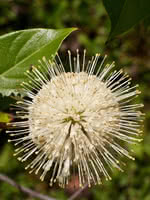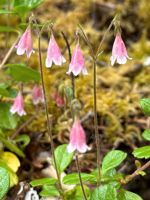Mon-Fri 9am - 5pm Mountain time
Buttonbush vs Twinflower
Cephalanthus occidentalis
Linnaea borealis
CUSTOM GROW
CUSTOM GROW
Buttonbush is a moisture loving shrub that provides year round interest.
It has round, fragrant flowers resembling small buttons or pincushions. The flowers transform into small reddish-brown fruit that persists into winter while the leaves take on shades of red in fall.
Providing essential food to bees, butterflies, and other insects, this shrub is versatile. Try it in your next shrub border.
Twinflower is a native, trailing evergreen ground cover known for its delicate flowers that grow in nodding pairs. These pale pink blooms are described as being sweetly fragrant, attracting native bees and other pollinators.
Growing in cool, moist, acidic soils, the trailing stems form roots as they spread and start to form mats across the forest floor. Due to its woody stem, it is technically classified as a shrub and often referred to as a subshrub or dwarf shrub. This species is well-suited for naturalization, restoration, and conservation projects.
Twinflower (Linneae borealis) was named in honour of Carl Linnaeus, who adopted it as his personal emblem.

